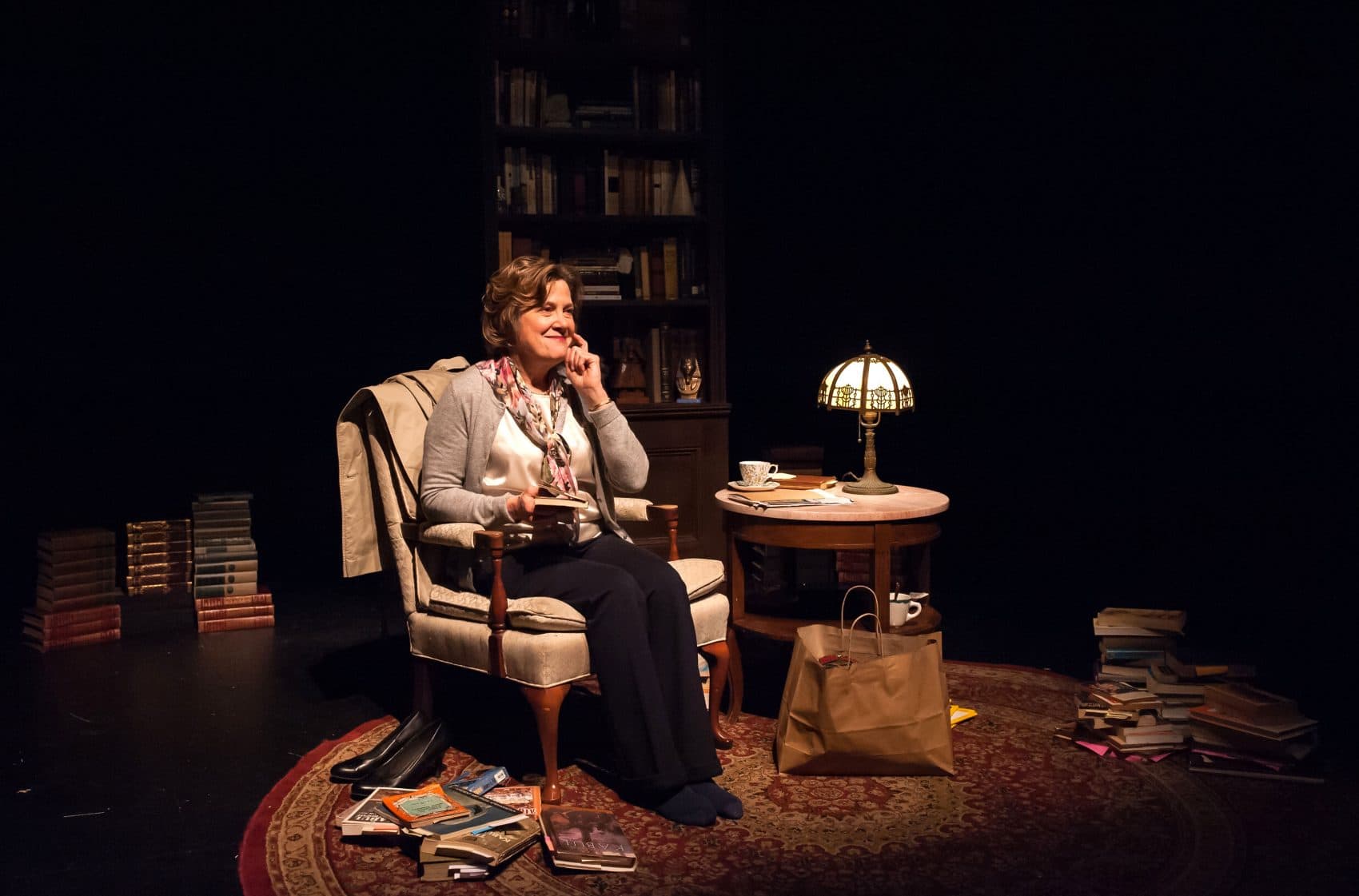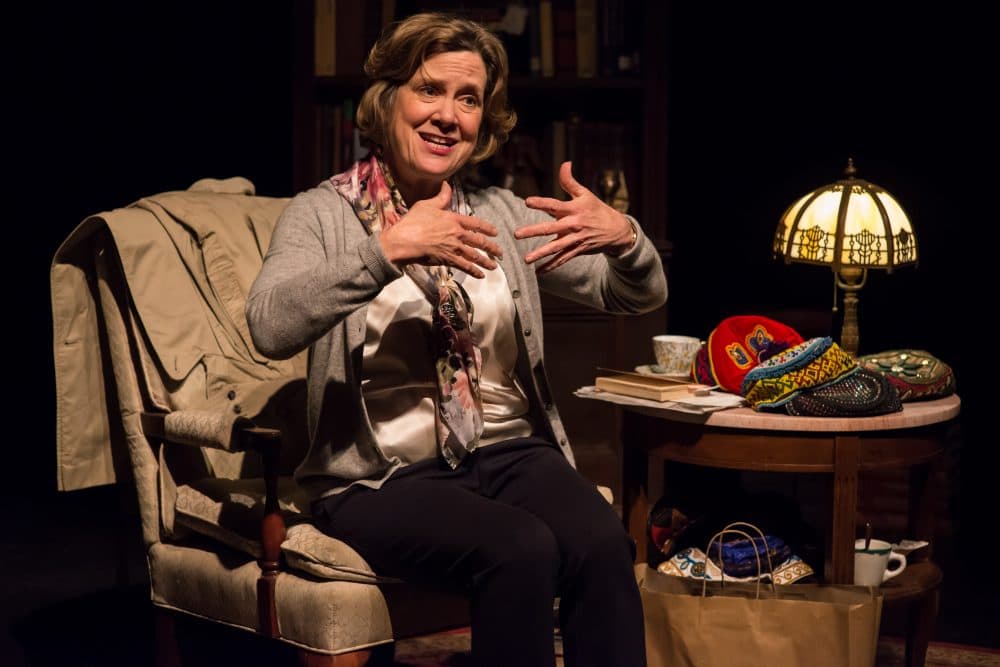Advertisement
Review
Tony Kushner's 'Homebody' Takes A Politically Charged Trip To Afghanistan

"The Homebody" — the middle-aged, somewhat brittle London housewife who serves as the title character in Tony Kushner’s deceptively complex one-woman carnival ride of ideas — is a chattery, restless bundle of nerves.
Underground Railway Theater artistic director Debra Wise fills the room with emotional and intellectual energy for 70 minutes, creating a space in which geography, history and philosophy grapple with more personal experiences — disappointment, curiosity and, most keenly, a sense of being driven out the door and away from familiar comforts. The Homebody, biological clock ticking and mind alive to possibility, is feeling a tug to set sail. I can’t say I liked the play so much; it was more that I was pleasurably rolled around in its tidal verbiage and conceptual surge.
Wise’s portrayal of Kushner’s tentative, dissatisfied bibliophile is almost alarmingly spot-on. The Homebody speaks of her interests being “moth-like” in their searching, erratic flutter; she herself is a slightly moth-eaten soul, left weary and a little ragged by a life of restrictions, some imposed, but many the result of her own sense of caution. However, while a ship in harbor might be safe, it’s as the saying tells us: That’s not what ships are for.

In a physical sense, The Homebody has scarcely left her home in who knows how long. Her forays into the world consist of trips to junk shops where antiquated or trivial items from other cultures are available for purchase, such as the Middle Eastern hats she buys in bulk for a party — the sort of embroidered, brightly colorful caps one imagines men wear in places like Istanbul as they enjoy cardamom-flavored coffee or draw smoke from hookahs. But her curiosity and imagination have soared across the globe — and across the centuries, too. Clutching an old travel book about Afghanistan, The Homebody provides an excited lecture on the region’s history, and the successive waves of conflict that shaped and reshaped its demographics, and hence its cultural and political character.
Popping up throughout her recitation are rueful ruminations about her own life. She’s married to a man who is so emotionally distant that he might as well be in Afghanistan himself, an ironic state of affairs given that his line of work is global communications. So desperate is The Homebody to connect with him that she samples his prescription medicines — tablets of yellow and red, she informs us, which she pops in order to better “understand his moods.” He does not reciprocate her efforts even though, in her generosity of spirit, she pours her own pills into an inviting dish.
Dotty, slightly dingy and, not incidentally, behind the times, The Homebody is the sort of intellectual adventurer who might, to her own detriment, impose her expanding personal boundaries onto more rigid borders that determine nations or historic eras; that is to say, she’s the sort of spiritually pure innocent whose hunger for the world is apt to be answered with annihilation from that world, thanks to its fallen nature and brutal habits.
Dotty, slightly dingy and, not incidentally, behind the times, The Homebody is the sort of intellectual adventurer who might, to her own detriment, impose her expanding personal boundaries onto more rigid borders that determine nations or historic eras.
But it’s not out of ignorance or mere boredom that The Homebody yearns to shake off the trappings of her daily life and get out of the circumscribed existence into which she has slid rather than ventured. As her mind has been stimulated by vociferous reading, she’s found herself in a quagmire that speculation and thought experiments cannot resolve; everything is impossibly tangled and intermingled. Rattling off a list of loosely associated fears and hopes, The Homebody at one point crystallizes her churning anxieties and cognitive dissonance with a paradoxical musing roughly to the effect that, “Only children with rifles can save us from children with rifles.”
Yes, the wide world is replete with misery and cruelty, and she’s privileged to have the luxury of a safe home in London — but she’s also vulnerable to moral and mental stagnation, and it’s that, more than anything, against which The Homebody kicks. When, at the curio shop, she notices the proprietor’s mangled hand — a badge of survival from some conflict or calamity she cannot even picture — The Homebody finds herself instantly and urgently attracted to him. Where will her need for escape take her? How far can she go?
Kushner originally wrote “Homebody” in the late 1990s as a monologue for British actress Kika Markham, but then he followed up with more — so much more, in fact, that the finished work, titled “Homebody/Kabul,” uses the monologue as a first act and then runs another three hours. Wise has opted to keep things simple and stick to the original monologue. It works. “Homebody” has a surprising, open-ended finish that could, but doesn’t have to lead to subsequent acts.
As it stands, the play piques one’s curiosity and teases the imagination. The design speaks to the intentionality behind Wise’s choice to present the original one-act monologue with a comfy chair, a table and a stack of books sketching the suggestion of a well-lived-in London flat. Wise’s costuming follows suit, so to speak, with her wardrobe depicting an English housewife from the 1960s or '70s. (Both set and costuming are credited simply to “The Company.”) URT’s production takes place in Central Square Theater’s black box space through May 7, running simultaneously with “Paradise,” another meditation of how Western and Eastern cultures clash and co-exist.
“Homebody” is an example to us: an encouragement to heed the inner voice that says comfort and security aren’t enough.
When “Homebody/Kabul” premiered, the events of Sept. 11, 2001 had taken place not long before. Kushner’s play, written before the terrorist attacks, was seen to be prophetic, especially the “Kabul” section, which shifts the action overseas and introduces an Afghani counterpart to The Homebody. The one-act version retains a potency and relevance to this moment that director Lee Mikeska Gardner identifies in her program comments, pointing out that “The Bad-Guys-via-Inertia” she fears are taking over the world — ideological bullies exploiting the reluctance of the majority to trouble themselves with active resistance — are the real life consequence that results when good people do nothing. In that way, “Homebody” is an example to us: an encouragement to heed the inner voice that says comfort and security aren’t enough. In fact, they may be nothing more than illusions we’ve been lucky to hold onto for long as we have.